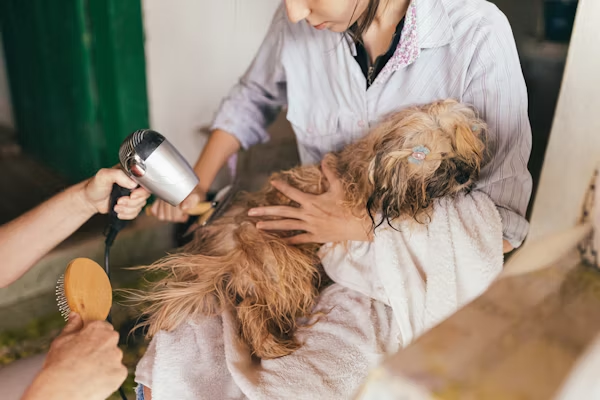As pet owners, it’s our responsibility to ensure that our furry friends remain safe and comfortable throughout the year. Different weather conditions can pose unique challenges for pets, and understanding how to adapt their care accordingly is crucial. This guide will provide you with seasonal pet care tips to keep your dog or cat healthy, happy, and safe in every season.
Spring Care Tips
Spring brings warmer weather, blooming flowers, and increased outdoor activities. However, it also presents certain risks for pets. Here are some tips for keeping your pets safe this season:
- Flea and Tick Prevention:
As temperatures rise, so does the prevalence of fleas and ticks. Consult your veterinarian for appropriate flea and tick preventatives, and ensure you treat your pet regularly. Consider checking your pet daily for ticks, especially after walks in wooded areas. - Allergy Management:
Spring can trigger allergies in pets, similar to humans. Watch for symptoms like sneezing, itching, or excessive scratching. Consult your veterinarian for appropriate medications or treatments. - Hydration:
As temperatures rise, ensure your pet stays hydrated. Provide fresh water at all times and consider bringing water on outdoor excursions. - Safe Exploration:
Spring is a great time for walks, but ensure your pet is on a leash to prevent them from wandering off or getting into harmful plants and flowers. Keep them away from poisonous plants like azaleas, lilies, and daffodils. - Grooming:
Regular grooming helps reduce shedding and mats, which can become problematic as your pet sheds their winter coat. Consider a visit to a professional groomer for a seasonal trim.
Summer Care Tips
Summer is full of fun outdoor activities, but it’s essential to be mindful of the heat. Here’s how to keep your pet safe during the warmer months:
- Heat Safety:
Dogs and cats can suffer from heatstroke. Avoid walking your pet during the hottest parts of the day, and look for signs of overheating, including excessive panting, drooling, or lethargy. Always provide shade and water during outdoor activities. - Never Leave Pets in Cars:
Even on mild days, the temperature inside a parked car can rise rapidly, leading to heatstroke or death. Always take your pet with you or leave them at home. - Swimming Precautions:
If your pet enjoys swimming, ensure they are safe around pools or lakes. Not all pets are natural swimmers, so supervise them closely and consider using a life vest for extra safety. - Paw Care:
Pavement can get extremely hot during summer, potentially burning your pet’s paws. Test the ground with your hand; if it’s too hot for you, it’s too hot for your pet. - Hydration and Nutrition:
Ensure your pet has access to fresh water at all times, and consider adjusting their diet to include lighter, hydrating foods like fruits and vegetables suitable for pets.
Fall Care Tips
As the weather cools, pets can enjoy the beautiful autumn scenery. However, there are precautions to take as well:
- Allergy Awareness:
Fall is a peak time for allergens like ragweed. Monitor your pet for allergy symptoms and consult your vet if necessary. - Safe Halloween:
Halloween can be stressful for pets due to costumes and trick-or-treaters. Keep pets in a safe, quiet space away from the noise. Ensure that Halloween treats are kept out of reach, as many are toxic to pets (e.g., chocolate, xylitol). - Warmth and Comfort:
As temperatures drop, provide warm bedding and consider adjusting their sleeping area. Older pets may require extra warmth to stay comfortable. - Daylight Changes:
Shorter days mean less natural light for outdoor activities. Ensure your pet still gets enough exercise, adjusting walks to the available daylight. - Grooming for Cooler Weather:
Fall is a great time for grooming to remove excess fur and prepare for winter. Regular brushing helps reduce shedding and matting.
Winter Care Tips
Winter can be tough for pets, especially those that aren’t accustomed to cold weather. Here are tips to keep them safe:
- Cold Weather Precautions:
Limit outdoor time during extremely cold weather. If your pet must be outside, consider using a pet sweater or coat, particularly for short-haired breeds. - Paw Protection:
Ice, snow, and salt can be harsh on your pet’s paws. Consider using pet-safe ice melt products and check your pet’s paws after walks for salt or ice accumulation. - Nutrition Adjustments:
Pets may require more calories in winter to maintain their energy and warmth. Consult your veterinarian for dietary adjustments. - Indoor Enrichment:
When it’s too cold outside, provide indoor activities to keep your pet engaged. Puzzle toys, interactive games, and training sessions can help keep their minds active. - Hydration:
Ensure your pet stays hydrated, as pets can still become dehydrated in winter. Ensure they have access to fresh water, which may freeze in outdoor bowls.
General Tips for Year-Round Pet Care
- Regular Vet Check-ups:
Schedule regular check-ups to monitor your pet’s health, vaccinations, and any necessary medications. - Identification and Microchipping:
Ensure your pet has proper identification, including a collar with an ID tag and a microchip, to increase the chances of a safe return if they get lost. - Monitor Behavior Changes:
Keep an eye on any changes in behavior, appetite, or energy levels, which may indicate health issues requiring veterinary attention.
Conclusion
Keeping your pets safe and comfortable throughout the year requires understanding the unique challenges posed by each season. By following these seasonal care tips, you can ensure your dog or cat enjoys a happy, healthy life no matter the weather. Regular veterinary visits, a safe environment, and attentive care can help you create a safe haven for your beloved pets all year round.











Leave a Reply